The technical challenge is to increase the functionality of the finger prosthesis and make it cheaper and easier to manufacture thanks to 3D technology.
![]()
- Finger prosthetics in Israel
- work steps.
- Active prostheses (pull prostheses)
- Externally powered prostheses
- Benefits of treatment with ServiceMed:
- ear prosthesis
- Computer simulation of the ear
- eye implants
- Pictures
- Summary
- Amazing artwork, superb personalization, precise measurements
- Prosthetic Toe Technology.
- Cosmetic finger prostheses
- Cosmetic hand prosthesis
- Finger flexor plastic (restoration of mobility)
Finger prosthetics in Israel
Finger and toe prosthetics in Israel The prosthetics center carries out prosthetics in the shortest possible time: 2-4 weeks. Prosthetics uses advanced technologies, modern materials and components. The range of prostheses is very wide and is aimed at people of all ages, with different degrees of amputation and mobility: seniors, people with an active lifestyle, athletes, etc.
Every amputation case is unique. Every prosthetic fitting has its own requirements. In order to realize the various prosthetic options for lower limb amputations, we offer a wide range of proven products and services. They develop new technologies and prostheses based on a thorough study of the musculoskeletal system and strive to provide their patients with the best possible mobility and quality of life.
- A consultation with an orthopedic surgeon to discuss possible prosthesis options and assess the patient's physical and physiological abilities.
- prostheses;
- training in handling the prosthesis;
- warranty services;
- Possibility to purchase user-friendly prosthetic aids such as residual limb care products, residual limb covers made of high-quality materials, insoles for all amputation degrees, medical supplies, walkers, wheelchairs, crutches, canes, bandages, orthoses, etc.
- Full instructions in Russian.
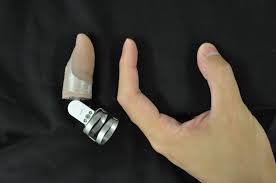
On the 1st day there is a consultation with an orthopedic technician:
- The model of the prosthesis is selected and the size determined;
- A suitable model is made, taking into account the correct orientation of the functional units, and is pre-tested;
- The prosthesis model is made according to the individual characteristics of the receptive defect;
- The patient is instructed in the correct use of the prosthesis.
work steps.












The adaptation of the upper limb prosthesis is selected on the basis of various parameters and individual requirements.
Depending on the degree of foreshortening, there are:
Depending on the purpose, upper limb prostheses are cosmetic or functional. In the first case, it is an optical replacement of the lost arm. The prosthesis is very realistic and resembles a fully functional limb. It is made with the help of real sculptors who take into account skin color, veins, natural wrinkles and other subtleties. The disadvantage of this type of prosthesis is the limited functionality of the upper limbs. The prosthesis consists of a socket, a frame and a shell. Silicone is used for production.
Functional prostheses for the upper limbs have a different level of difficulty. The function of the device depends on how it works:
- Work. They are designed to perform a variety of complex tasks. With these prosthetic arms, additional devices are used for specific activities at work or at home: writing, sewing, drawing, gripping tools, and other tasks. The disadvantage of the prostheses is their specific appearance, which does not resemble the human arm. There is an opportunity to use a cosmetic accessory if necessary;
- traction, or active. Available with active and passive grip controlled by human effort without the use of electronics. As the other arm moves, the cable tightens or relaxes, allowing the wrist to move. Thanks to a simple and robust mechanism, it is possible to control the speed and strength of the grip. Over time, the person with these artificial limbs can make delicate movements and hold objects, as well as write, type, and carry a bag. The constant muscle tension helps the vestigial limb to form properly and adapt to the complex bionic prosthesis;
- Bionic. An advanced type of upper limb prosthesis. They use the energy of an electric motor or a battery. They are controlled by signals from the patient's skin. A change in electrical potential is detected by EMG sensors in the base of the stump, which relay a signal to a microprocessor, allowing the prosthesis to perform a specific action.
Active prostheses (pull prostheses)
An active prosthesis is fully controlled by the user, without the use of electronics. She is able to hold various objects in her artificial hand. This type of prosthesis allows the hand to contract and tighten with the help of mechanical cables (wires). You can choose an artificial hand with an active or passive grip.
The artificial fingers are opened by springs, while the user closes and holds the device. Such prostheses can be made for almost all types of mutilations. The most advanced and functional active hand prosthesis is the 'left hand' prosthesis developed in our company.
The patient opens the artificial hand or flexes the elbow while the spring closes the hand with the elbow module (for shoulder prostheses) resting on the lock. With these prostheses, the gripping force is directly proportional to the spring tension and the patient does not receive any feedback from the hand. The quality of the drawing hand is determined by the number of fingers open, the strength of the grip, and the ease of opening.
Externally powered prostheses
Externally powered prostheses use batteries and electric motors and are controlled by electrical signals from the patient's skin. This group of prostheses is more commonly referred to as bionic (due to the type of control) or bionic.
The latest models combine great looks with remarkable gripping power and speed, and fulfill many additional functions.
The latest versions of the bioelectric hand are equipped with special sensors that monitor the grip strength of an object. These sensors are located in the area of the fingertips. They allow the user to grasp a variety of objects, including objects as fragile as plastic cups or e.g. B. an ordinary chicken egg without fear that it will break or be crushed.
Scoliologic.ru manufactures all types of externally powered prostheses, including those that can be displaced.
Benefits of treatment with ServiceMed:
- Rapid implementation of all advanced innovations in prosthetics.
- Individual adaptation of prostheses, with custom-made products on request
- Advice on the use and care of the prosthesis
- Excellent recovery opportunities after important treatments
- Comprehensive support and comfort at home in Israel
Typing on a keyboard, playing a musical instrument, tying shoelaces... The possibilities of modern finger prostheses are almost unlimited.
Give yourself the chance for a new and fulfilling life!
LEARN ALL ABOUT THE COST AND CHARACTERISTICS OF PROSTHETICS ISRAEL
Physician Boser ItamarChief Physician, Tell Hashomer Arthroscopy Unit, ServiceMed Specialist
His scientific and practical work is known beyond the borders of Israel, and he has written studies and articles. His specialty is sports orthopaedics. He has performed numerous joint surgeries.
biography online
office hours
resume online
office hours
biography online
Advice
ear prosthesis
With an ear prosthesis, an artificial ear is made in the same way as a healthy ear. The ear prosthesis sits firmly on the head and looks just like a real ear.
The success of placing a prosthesis depends largely on the skill of the surgeon. The more precisely the color and shape of the artificial ear is matched, the better the result. Even if the color of the artificial ear is perfectly matched to the skin, the patient should avoid the sun because the artificial ear does not tan like normal skin.
Computer simulation of the ear
First, a healthy auricle is scanned with a special device or a 3D scanner. Then the specialists create a digital mirror copy of the ear, on the basis of which an ear implant or just the missing part is made.
Based on the first computer simulation, a very precise 3D copy of a healthy pinna can be created. This virtual projection also helps the surgeons during the operation.
The materials used are fully compatible with living tissue and do not trigger rejection reactions. Upper ear implants made of medical silicone (e.g. Metpor) are particularly soft and do not damage the skin during sleep.
![]()
eye implants
Implants are used when the eyeballs have been lost due to various diseases or injuries. If the eyelids are spared, doctors make a prosthesis similar in color and size to the adjacent eye and place it in the socket. If the eyelids are damaged, 2-3 implants are first placed in the orbital bones, which hold the artificial eye firmly in place. Magnets are attached to these implants, which are securely connected to the magnets in the prosthetic eye. This allows the patient to remove the eye implant themselves to clean it and the eyeball if necessary, and then put it back in.
The shape of the nose is often restored by transplanting tissue from the forehead or other parts of the body. However, if a prosthesis is not possible for medical reasons or the patient does not want to undergo a tissue transplant, artificial limbs can also be used to replace the defect.
Pictures
- A – HUMAN NEEDS
- A61 – MEDICINE OR VETERINARY SCIENCES; HYGIENE
- A61F - FILTERS IMPLANTED IN BLOODLINES; SIMPLY; DEVICES FOR OR PREVENTING DETACHMENT FROM TUBULAR BODY STRUCTURES, e.g. B. STENTS; ORTHOPEDIC, NURSING OR CONTRACEPTIVE DEVICES; RESPIRATORS; DEVICES FOR THE TREATMENT OR PROTECTION OF THE EYES OR EARS; BANDAGES, BANDAGES OR ABSORBENT PADS; FIRST AID KITS
- A61F2/00 - Filters implanted in blood vessels; Prostheses, ie artificial replacements or substitutes for body parts; devices for connection to the body; Devices for ensuring patency or preventing collapse of tubular structures of the body, e.g. B. stents
- A61F2/50 - Non-implantable prostheses in the body
- A61F2/54 - Artificial arms or hands or parts thereof
- A61F2/58 - elbow; wrists; other joints; hands
- A61F2/583 - hands; wrist joints
- A61F2/586—fingers
Summary
One useful design relates to medical technology, namely a finger prosthesis, namely a traction prosthesis. A traction finger prosthesis having a base, a first phalanx pivotally attached to the base, and at least one trailing phalanx pivotally attached to the first phalanx, and an actuator for repositioning the trailing phalanx relative to the first phalanx and the first phalanx relative to Base, at least one return member for returning the first phalange and the following phalange to the starting position, the actuator being driven by a cable attached to one end of the distal phalange and to the other end of the phalange. The technical challenge is to extend the functionality of the finger prosthesis up to 90° with the possibility to control the prosthesis by tactile devices. The technical challenge is to expand the functionality of the prosthetic finger with the possibility of making it cheaper and simpler using 3D technology. The technical result aims to improve human interaction with the objects around him using an artificial finger and to minimize the response time from sending the residual muscle activity to the flexion of the prosthetic limb, simplifying the design of the installation process, without external help resort and without surgical intervention.
A useful model relates to medical technology, namely the prosthesis of a finger or group of fingers of the hand, namely a traction prosthesis.
A driving device for a substantially life-size finger prosthesis is known, which serves to bend the finger prosthesis about a rod in relation to a fixation, for example in a human or artificial metacarpal. The drive device includes a motor, which can be connected to a power source such as a battery, and a gearbox, which serves to transmit the power of the motor to the prosthetic finger in order to move it. The motor and the gear are arranged in the prosthetic finger in such a way that the flexible shaft is located in the prosthetic finger or in its extension on a handle (WO 03/017876 (A1), op. 2003-03-06).
Amazing artwork, superb personalization, precise measurements
Appearance, quality and durability are optimal.
They are made by integrating MG hyper-realistic faux leather (exclusive formula) and other special components. As well as exclusive (technological, orthopedic, anatomical, mechanical and cosmetic).
Aesthetic and hyper-realistic, very natural. With morphology, color, tone, texture, folds and other details that very realistically imitate those of the patient.
Innovation and exclusivity through the development, design and production of state-of-the-art devices for the fingers of the human hand. Technology that combines orthopedic, artistic components with other elements that manage to replace cosmetically and anatomically, in many cases also improving the functionality of the hand or depending on the missing part.
A very special solution for patients with amputations, deformities, partial or total deformities of one or both hands. Injuries that can be due to traumatic causes, as a result of illness or congenital.Modern hand orthoses* MG LATAM are made on the basis of the patient's individual examination and injuries.
Thanks to the craftsmanship of specialists who create a product with the perfect aesthetic appearance and the anatomical dimensions of the person. The ability to mimic the patient's unique characteristics in detail. They not only improve health and are aimed at rapid, natural and gentle rehabilitation.
MG LATAM's advanced orthopedic finger prostheses surpass all prostheses made with industrial, traditional or conventional techniques, which are the most common products with 94 % of the world market.
The incorporation of orthopedic and ergonomic components, also made to measure, increases or restores resilience and mobility, avoiding or preventing wear and tear, damage and consequences, as well as pain and its causes.
Prosthetic Toe Technology.
Exclusive manufacturing technology. The perfect combination of physical and digital 3D technology with art. Always looking for the most natural and gentle way to compensate for the orthopedic defect while improving the aesthetics of the patient's and/or wearer's body.
Interpret, reproduce, reconstruct each patient's anatomy and cosmetics. Perfect imitation of the actual appearance of each human. Artificial reconstruction of HANDS affected by mutilation, deformity or genetic defects.
Finger prostheses contain basic information about the person: morphology, unique and characteristic anatomical features such as size, color, tone, skin texture. If so, including details like birthmarks, freckles, blemishes, veins, and even tattoos.
All of this can be achieved through close contact with the patient throughout the manufacturing process. In this way, the prosthesis adapts to any degree of loss, whether it is a total or partial amputation, with or without a residual limb.
For the most difficult of FINGERHANDEN cases, you can check with your MG LATAM specialist about existing alternatives or request a custom order.
The finger prostheses are guaranteed to adapt naturally and are like an extension of the body. They adapt perfectly to the rest of the area. They will NOT sag or weaken with daily use. They can be put on and taken off in seconds and fit perfectly.
In most cases (depending on the consequences, care, recommendations and type of injury), prosthetic toes do not require any chemical or special equipment, adhesive and dressings for daily wear. There are no special techniques or additional equipment to remove them.
Cosmetic finger prostheses
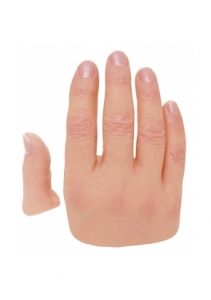
For patients with toe defects. The prosthesis is a flexible polymer part with a receiving cavity that is placed on the residual limb and held in place by the elasticity of the material. The prosthesis compensates for cosmetic defects and allows performing some of the functions associated with pressing and holding light objects.
Cosmetic hand prosthesis
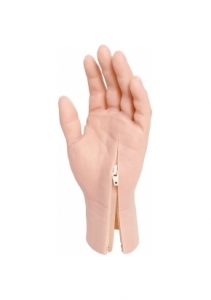
Partial replacement of the aesthetic features of the upper limbs lost due to amputation or congenital malformation of the hand.Cosmetic forearm prosthesis
For patients after unilateral or bilateral forearm amputation to restore the aesthetic features of the upper limb. Consists of a custom made acetabular cup and cosmetic hand.
Finger flexor plastic (restoration of mobility)
Here is Patient O's story.
A young man cut himself with a knife, the wound was deep and he was taken to hospital where he underwent surgery to sew up the deep flexor tendon of his fifth finger.
After difficult rehabilitation, the finger could be flexed but not fully extended and the tendon 'floated'. This was due to the flexor tendon channel being too open for the suture.
The patient came to me more than a year after the injury. We discussed all the treatment steps in detail and decided on a long and difficult road to recovery.
A very important requirement for the first phase was full passive movement of the injured finger.In the first phase, the stitched and shortened flexor had to be removed and a silicone tube placed around which a new canal was created. The removed flexor tendon is not disposed of in any way, but is used to rebuild the annular ligament around the main limb.

The operation was performed on an outpatient basis under local anesthesia without bloodletting, and the patient did not have to spend a single day in the hospital.
After the skin healed, the thumb looked like this:
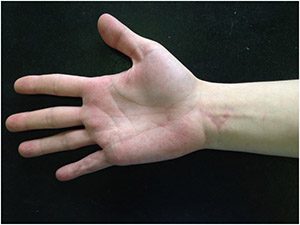
The scars are usually not very visible on the hand. The wrist V access is where the silicone tubing ends.
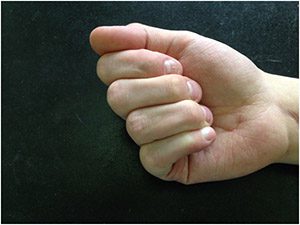
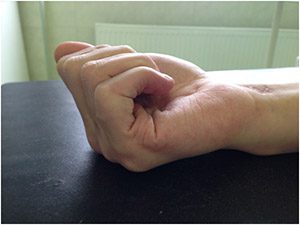
- Modern leg prostheses.
- prosthetic leg.
- prosthetic legs.
- Leg prosthesis below the knee.
- Limb prostheses are.
- prosthetic foot.
- prosthetic finger.
- prosthetic finger.


